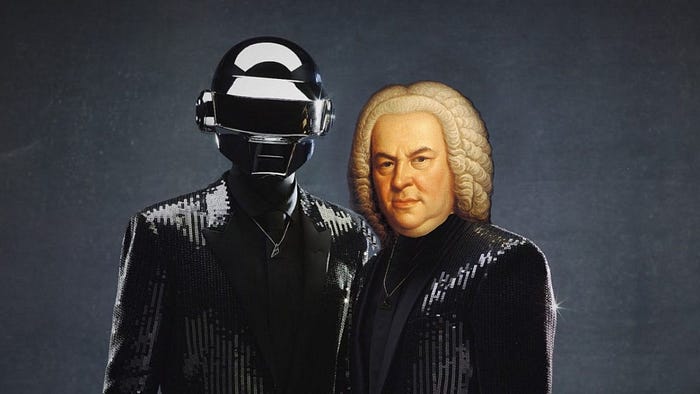
Bach-t Punk: An analysis of the music of JS Bach and Daft Punk
The Baroque period is widely acknowledged as the fundamental basis that modern music is based on. With the emergence of functional harmony, elaborate use of motif and a set bassline, the period set the precedent for the next few hundred years. While much has changed since then, and there are arguably such huge similarities between the structures and musical devices between then and now, it is rare to see a modern artist whose compositional techniques are as akin to Bach’s as Daft Punk.
For me, the parallels between the style of Daft Punk, and traditional Baroque works have been very clear, albeit surprising. When you listen to Daft Punk’s work, it immediately draws you in in the same way that Baroque pieces do: with an initial strong melody:
B.1 Bach, English Suite I Gigue b.1–3
D.1 Daft Punk, Da Funk b.1–4
This strong melody is the major instigator of the “catchiness” in both artists work. It is the initial melody, or motif a, that distinguishes the piece. In B.1 and D.1 the 3 and 4 bar melodies make up the motif a, however the size and intricacy of the melody here varies slightly. Working in much the same way as the modern “hook”, both themes work in the circular way that they move nicely back to the beginning of the theme. Immediately there is a distinction between the Bach and the Daft Punk, in that the Bach is much more intricate, but the Baroque principle about the themes is exactly the same. Daft Punk rely on the strength of the initial theme and run with it, moving it in similar, but less extensive ways to those of Bach, where, in the First English Suite Gigue, the theme is manipulated as a fugal subject across both hands in the piano part.
On fugal writing, Bach’s expertise is widely known. Daft Punk have, however, demonstrated loose elements of fugal writing. Take One More Time, for instance. The song is made up of a selection of short interlocking melodic motifs, a somewhat static bassline which doesn’t affect the fugal structure, and variations on the motifs. This can be loosely interpreted as follows:
One More Time : Subject
One More Time/We’re gonna celebrate : Tonal Answer/Countersubject 1
Music’s got me feeling so free/celebrate and dance so free : Countersubject 2
The song opens with the subject and the tonal answer like would be expected in a traditional fugue, the main difference being strictly incorrect harmonic and melodic-length. The similarities go further, however. Once the initial “Episode” has happened, the main body of the verse happens, which in fugal terms would be free counterpoint. After this, there is a “Stretto” section, with false entries of the subject, answer and countersubject’s in a contrapuntal way, leading to the final crescendo of the song, which ends with a final entry of the subject.
(There are clear distinctions between One More Time and a real traditional fugue, but the similarities are pretty evident when displayed in this way, and One More Time is a great example of how traditional structures can be used in the modern day pop song.)
The use of bassline in both artists’ work is pretty prevalent and obvious, so is barely worth a mention, but it is important in the specific context that Baroque work such as the Passacaglia and Fugue in C minor, which employs an ostinato as a bassline, but it also acts as a defining part of the sound of the piece:
B.2 Bach, Passacaglia and Fugue in C minor B.1–8
The bassline on Daft Punk’s Around the World, whilst being much shorter and less harmonically advanced, is used in an identical way to Bach’s:
D.2 Daft Punk, Around The World b.1–4
This rough notation shows the initial bassline, which in an almost identical, functional and formatted way to Bach’s, is added to and built up until the end of the work. Bach’s Passacaglia at times has 3 parts playing independent of the ostinato, and Around The World has exactly the same, and they are related to the bassline almost identically to Bach’s. To this extent, Around The World is one of the most “Bach-like” pieces because of its closeness of bassline, melodic and structural intertwining and harmonic relationships.
In conclusion, whilst there are dramatic differences between the disciplines of both Johann Sebastian Bach and Daft Punk, the similarities between the two musical styles are remarkably striking and evident, and certainly food for thought for the modern musicologist.
When I was writing this, a friend of mine said to me, “if you say that can’t you say that about all artists?” and the answer is, well, yes. The underlying point here is two-sided. Firstly, the impact of “Classical” artists on the modern world can never be underestimated, and most importantly the validity of musical form for all artists, no matter what the purpose or audience.
This is an excerpt from a longer analysis.
Sam Marshall is a freelance musician, writer and reviewer based in SW UK.